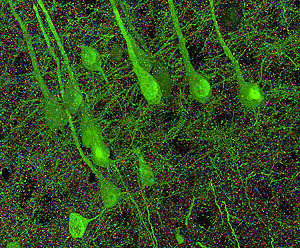There are as many “transistors” in the human brain as in the global IT infrastructure
Stanford neuroscientists have spent several years developing a new way of 3D brain scanning. They combined three-dimensional computed tomography (array tomography - the technique of “antenna arrays” from radio astronomy) and specially developed software to get a three-dimensional and realistic 3D model. One that can be moved, scaled and rotated in different dimensions.
After studying the picture, the scientists concluded that the synapses are much more complex than previously thought.
A healthy human brain contains about 200 billion nerve cells, which are connected to each other by hundreds of trillions of synapses. Tens of thousands of synapses can move away from each nerve cell. In the human cerebral cortex alone, there are about 125 trillion synapses - 1500 times more than the stars in our galaxy.
According to the results of the visual reconstruction of the data, scientists found that each synapse contains about 1000 molecular “switches”, such analog transistors. That is, a separate synapse can be compared with a microprocessor. It turns out that the number of "transistors" in the human brain now needs to be increased by three orders of magnitude. There are more of them than transistors in all computers on the planet and routers combined.
')
The calculation is as follows:
On the one hand, someone can conclude that we are still very far from creating artificial intelligence. On the other hand, already on the basis of the current infrastructure, you can run a real human brain model of 1: 1. It is only necessary to understand what program synapses are working on, that is, to decipher all biochemistry.

The results of the study on the visual reconstruction of data from volumetric computed tomography were published in the journal Neuron . Scientists received a patent and applied for a second, and also founded the company to commercialize a new tomography method.
via Health Tech
Scan from the soft shell of the mouse brain cortex through six layers and subcortical white matter to the adjacent striatum.
After studying the picture, the scientists concluded that the synapses are much more complex than previously thought.
A healthy human brain contains about 200 billion nerve cells, which are connected to each other by hundreds of trillions of synapses. Tens of thousands of synapses can move away from each nerve cell. In the human cerebral cortex alone, there are about 125 trillion synapses - 1500 times more than the stars in our galaxy.
According to the results of the visual reconstruction of the data, scientists found that each synapse contains about 1000 molecular “switches”, such analog transistors. That is, a separate synapse can be compared with a microprocessor. It turns out that the number of "transistors" in the human brain now needs to be increased by three orders of magnitude. There are more of them than transistors in all computers on the planet and routers combined.
')
The calculation is as follows:
- 1,25E14 synapses in the brain
- 1000 synapses in each synapse
- it turns out 1,25E17 molecular switches in the brain
- Since 2005, microprocessors in approximately 1E8 transistors (from 2010 began to make 1E9)
- suppose in the world of 1E9 computers
- it turns out that in all computers on Earth 1E17 transistors
- 1.25E17> 1E17, pt.d.
On the one hand, someone can conclude that we are still very far from creating artificial intelligence. On the other hand, already on the basis of the current infrastructure, you can run a real human brain model of 1: 1. It is only necessary to understand what program synapses are working on, that is, to decipher all biochemistry.

Visual reconstruction of the data of volumetric computed tomography of synapses in the postcentral gyrus of the mouse, which responds to hair stimulation. Neurons are illuminated by a green fluorescent dye injected into the brain. Due to this, smaller synapses can be distinguished in the mass of nerve cells.
The results of the study on the visual reconstruction of data from volumetric computed tomography were published in the journal Neuron . Scientists received a patent and applied for a second, and also founded the company to commercialize a new tomography method.
via Health Tech
Source: https://habr.com/ru/post/108483/
All Articles